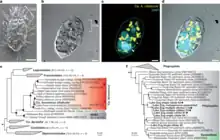| "Candidatus Azoamicus ciliaticola" | |
|---|---|
 | |
| Scientific classification | |
| Domain: | |
| Phylum: | |
| Class: | |
| Order: | |
| Family: | incertae sedis |
| Genus: | "Candidatus Azoamicus" Graf et al. 2021 |
| Species: | "Ca. A. ciliaticola" |
| Binomial name | |
| "Candidatus Azoamicus ciliaticola" Graf et al. 2021 | |
"Candidatus Azoamicus ciliaticola" is a candidate species of endosymbiotic bacteria belonging to the eub62A3 group of Gammaproteobacteria, characterized for its capacity to perform denitrification within its ciliate host in anaerobic water environments. It was isolated from Lake Zug in Switzerland and described in 2021.[1]
Ecology
"Ca. A. ciliaticola" is an obligate endosymbiont of an anaerobic freshwater ciliate from the class Plagiopylea. Endosymbiont contains highly reduced genome with 0.29 Mbp while substantial fraction of this genome is dedicated to energy production. "Ca. A. ciliaticola" contains complete gene set for denitrification and is thus the first observed obligate endosymbiont with such pathway.
Extensive genetic potential for energy metabolism hints that the main function of an endosymbiont is to generate ATP and provide it to its ciliate host. Ca. A. ciliaticola thus have functions which are similar to mitochondria, although it is not derived from a mitochondrial line of descent.
It provokes question if also some other eukaryota are using Prokaryotes to transfer electrons to non-canonical electron acceptors such as in the case of denitrification.
Other links
References
- ↑ Graf JS, Schorn S, Kitzinger K, Ahmerkamp S, Woehle C, Huettel B, et al. (March 2021). "Anaerobic endosymbiont generates energy for ciliate host by denitrification". Nature. 591 (7850): 445–450. Bibcode:2021Natur.591..445G. doi:10.1038/s41586-021-03297-6. PMC 7969357. PMID 33658719.